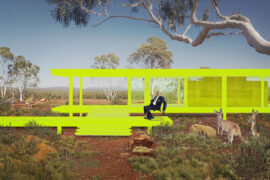Fresh from her trip to the World Architecture Festival in Lisbon, Fender Katsalidis’ Nicky Drobis outlines four big ideas that will shape architecture in 2023.

Nicky Drobis, partner, Fender Katsalidis
January 30th, 2023
Fresh from attending the World Architecture Festival (WAF) in Lisbon last year, Fender Katsalidis partner Nicky Drobis returned to Australia with some unique insights into the ideas set to shape the design industries in Australia and around the globe in 2023. She sets them out for us here.
In almost every project presented at WAF, regardless of its typology, the presenter would speak about responsible architecture, giving back to our cities and how their project improved connectivity with the public. Whether it was a residential, commercial or even a manufacturing building, there was a consistent focus on the ground plane condition and how it interacted with its surroundings.
The societal pendulum has absolutely swung towards sustainability and social responsibility, and there’s a stronger sense of accountability within the profession. While good intentions have always been at the heart of a designer’s objective, commercial considerations over the last few decades have driven the industry to design projects that could have been more responsive.
However, there has been a beautiful reawakening of the things that truly matter, with the changing values of our cities post-pandemic revealing how architecture can foster holistic outcomes.
Nicky Drobis, partner, Fender Katsalidis.
Part of the joy of a global conference is the opportunity to learn more about the unique projects being delivered around the world and celebrate how different environments and cultural influences inform design outcomes.
To me, there were two terrific, stand-out projects that were completely distinctive from what we would typically see in Australia. One was the Pingtan Children Library, by Condition_Lab, which won World Interior of the Year for its low-cost timber design, creating an attractive and light-filled space for children to read and play. The second was Agrotopia, a highly sustainable Belgian project by van Bergen Kolpa architects and META architectuurbureau that is Europe’s largest research centre for urban food production and won the prize for best use of natural light.
It’s always great to see Aussies being represented on the world stage, and there was a really strong Australian contingent of local architects kicking goals at WAF, with a Sydney-built project even taking out World Building of the Year. Bolstered by this, there is a tremendous opportunity for Australian architects to stay wary of homogenisation and focus their attention on telling uniquely Australian stories through the projects we design.
As community engagement becomes a higher priority among designers, particularly working with Traditional Owners on projects that acknowledge their histories and futures, I believe there will be strong progress made in local design that better reflects our own environment and culture.
Nicky Drobis, partner, Fender Katsalidis.
With sustainability establishing itself as a top talking point at WAF, discussion continues to surround our inner-city built environment and whether vertical living can be conducive to environmental and social well-being.
While there is consensus around the need to stop urban sprawl to limit the clearing of the natural environment to support housing developments, one challenge that inner-city projects face is that the newer success stories remain unproven. Large projects can take a decade to complete, so there aren’t a lot of built examples that can demonstrate the positive impact of contemporary design in our CBD towers.
However, small moves in a big building can have enormous repercussions. An architect may only need to change skirting board specs or the glazing ratio on a facade to make a significant difference in a building’s carbon emissions, so the difference between these decisions is impactful.
Nicky Drobis, partner, Fender Katsalidis.
And, as technology evolves rapidly, innovation in design and materiality innovation will continue to revolutionise the industry and society more broadly.
Socially responsible buildings, community and sustainability aren’t traditionally associated with high-rise buildings, but it would be foolish to ignore the realities of modern life. To discredit these towers is to ignore half of our homes, offices and urban communities, and I believe that in 2023 there will be plenty of debate and transformation in this space.
WAF brought together architects and industry leaders from around the world for candid discussions around the biggest issues shaping the industry, and there was plenty of open dialogue, tough questions asked and complex topics debated, which sometimes surprised me.
In a sense, these candid conversations are reflective of the direction the entire industry is headed, as relationships around the table change. Designers now engage with clients in a collaborative way, and in many cases, the two stakeholders may be equal in design footing. Stakeholder management operates on a round table, with clients becoming one of the team. This is often a positive thing and enables designers to deliver comprehensive design outcomes with a balance of commercial and environmental success.
Locally, this round table approach to stakeholder management is also starting to extend to the general public.
Australia is absolutely undergoing a design awakening. As a society, there is increasing passion for architectural outcomes – seen in the proliferation of home renovations – as people realise the positive impact good design can bring to enhancing their lifestyles and the correlation between their environment, wellness and wellbeing.
Nicky Drobis, partner, Fender Katsalidis.
As designers, we are dealing with a far more educated and impassioned client group than we ever have before, and in 2023 I believe that will only continue to grow.
Nicky Drobis is a partner at the multi-disciplinary international design firm Fender Katsalidis.
Fender Katsalidis
fkaustralia.com
We think you might like this story on four industry leaders who have been honoured as luminaries in the 2022 INDE.Awards.
INDESIGN is on instagram
Follow @indesignlive
A searchable and comprehensive guide for specifying leading products and their suppliers
Keep up to date with the latest and greatest from our industry BFF's!

For Aidan Mawhinney, the secret ingredient to Living Edge’s success “comes down to people, product and place.” As the brand celebrates a significant 25-year milestone, it’s that commitment to authentic, sustainable design – and the people behind it all – that continues to anchor its legacy.

London-based design duo Raw Edges have joined forces with Established & Sons and Tongue & Groove to introduce Wall to Wall – a hand-stained, “living collection” that transforms parquet flooring into a canvas of colour, pattern, and possibility.

From Valmont to GEYER VALMONT, Marcel Zalloua walks us through some of the milestones of what has been a fruitful, busy career in design.

The London-based architect was recently in Australia for SyLon, an event broadcast simultaneously in Sydney and London to explore housing solutions across both cities.
The internet never sleeps! Here's the stuff you might have missed

As the next event in a series of discussions centring on Richard Francis-Jones’ book comes to Brisbane, we hear directly from the speakers on fences, villas and the importance of critical community.

Karndean’s newly evolved Opus range brings versatility and durability to the forefront of commercial flooring. Blending design-led aesthetics with robust, high-performance functionality, it’s a go-to solution for spaces that demand both style and resilience.